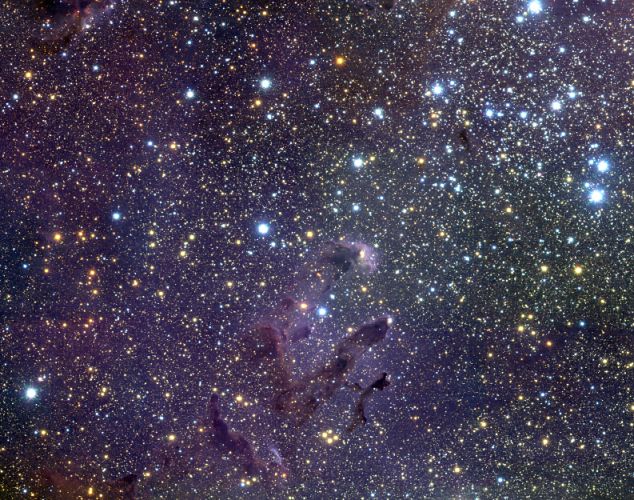Explanation: The Hubble Space Telescope's 1995 image of pillars of dust and gas, light-years long, within the Eagle Nebula (M16) was sensational. The three prominent pillars in that close-up visible light picture also appear below center in this wide-field mosaic along with massive, bright, young stars of cluster NGC 6611 (upper right), whose winds and radiation are shaping the dusty pillars. Made in near infrared light with the European Southern Observatory's 8.2-meter Antu telescope, this wide-field image makes the pillars seem more transparent, as the longer wavelengths partially penetrate the obscuring dust. While the Hubble image showed the pillar's startling surface details - over 70 opaque, finger-shaped lumps of material dubbed evaporating gaseous globules or EGGs, the near infrared view has allowed astronomers to peer inside. Comparing the two views reveals that nearly a dozen of the EGGs do indeed have stars embedded near their tips. More stars within EGGs may be detected if longer wavelength observations of the region are made. But which came first, the stars or the EGGs?
1999 2000 2001 2002 2003 2004 2005 2006 2007 2008 2009 2010 2011 2012 2013 2014 2015 2016 2017 2018 2019 2020 2021 2022 2023 2024 2025 |
Yanvar' Fevral' Mart Aprel' Mai Iyun' Iyul' Avgust Sentyabr' Oktyabr' Noyabr' Dekabr' |
NASA Web Site Statements, Warnings, and Disclaimers
NASA Official: Jay Norris. Specific rights apply.
A service of: LHEA at NASA / GSFC
& Michigan Tech. U.
|
Publikacii s klyuchevymi slovami:
star formation - NGC 6611 - Eagle Nebula - M 16 - Oblasti zvezdoobrazovaniya - Tumannost' Orla - zvezdoobrazovanie - globuly
Publikacii so slovami: star formation - NGC 6611 - Eagle Nebula - M 16 - Oblasti zvezdoobrazovaniya - Tumannost' Orla - zvezdoobrazovanie - globuly | |
Sm. takzhe:
Vse publikacii na tu zhe temu >> | |
